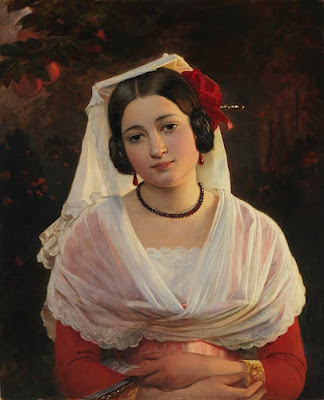 |
| André-Charles Voillemot Velleda ca. 1869 oil on canvas Musée des Beaux-Arts de Rennes |
 |
| Jan Massys Flora 1559 oil on panel Hamburger Kunsthalle |
-1919-gelatin-silver-print-Stavanger-Kunstmuseum-Norway.jpg) |
| Waldemar Eide Russian dancer Vera Fokina (Dying Swan) 1919 gelatin silver print Stavanger Kunstmuseum, Norway |
-National-Museum-Warsaw.jpg) |
| Anonymous French Photographer Model wrapped in Tulle behind a Balustrade ca. 1851 hand-colored daguerreotypes (stereocard) National Museum, Warsaw |
 |
| Francesco Furini Penitent Magdalen ca. 1642 oil on canvas Staatsgalerie Stuttgart |
 |
| Artemisia Gentileschi Venus and Cupid ca. 1625-30 oil on canvas Virginia Museum of Fine Arts, Richmond |
-c1784-oil-on-canvas-Museum-of-Fine-Arts-Boston.jpg) |
| George Romney Portrait of Emma Hart, later Lady Hamilton ca. 1784 oil on canvas Museum of Fine Arts, Boston |
 |
| Paul Chabas Seated Woman ca. 1890 oil on canvas National Gallery, Athens |
 |
| Friedrich Carl Gröger Portrait of the artist's daughter Lina Gröger 1815 oil on canvas Hamburger Kunsthalle |
 |
| Adolphe Piot Spring ca. 1900 oil on canvas Musée des Beaux-Arts de Reims |
-John-and-Mable-Ringling-Museum-of-Art-Sarasota.jpg) |
| Louis-Benjamin-Marie Devouge Presumed Portrait of Pauline Bonaparte Borghese 1811 oil on canvas (formerly owned by Joseph Bonaparte) John and Mable Ringling Museum of Art, Sarasota |
 |
| Anton Graff Portrait of Johanna Isabella von Broizem 1783 oil on canvas Alte Nationalgalerie, Staatliche Museen zu Berlin |
-c1808-oil-on-canvas-Mus%C3%A9e-Fesch-Ajaccio-Corsica.jpg) |
| François Gérard Portrait of Letizia Bonaparte (mother of Napoleon) ca. 1808 oil on canvas Musée Fesch, Ajaccio, Corsica |
 |
| August Riedel Portrait of Felice Berardi of Albano 1842 oil on canvas Neue Pinakothek, Munich |
-1641-etching-N%C3%A1rodn%C3%AD-Galerie-Prague.jpeg) |
| Wenceslaus Hollar Veiled Woman representing Summer (from series, The Four Seasons) 1641 etching Národní Galerie, Prague |
 |
| Franz Xaver Winterhalter Portrait of Lydia, Baroness Staël-Holstein ca. 1857-58 oil on canvas Virginia Museum of Fine Arts, Richmond |
from The Lyric "I" Drives to Pick up Her Children from School
"i" remembers that "as long ago as 1925, boris tomashevsky, a leading russian formalist critic, observed that the 'autobiographical poem' is one that mythologizes the poet's life in accordance with the conventions of his time. it relates not what has occurred but what should have occurred . . ."
* * *
"i" wishes she could remember abrams definition of the structure of the greater romantic lyric, but that it presents "a determinate speaker in a particularized, and usually localized outdoor setting, whom we overhear as he carries on, in a fluent vernacular which rises easily to a more formal speech, a sustained colloquy, sometimes with himself or with the outer scene, but more frequently with a silent human auditor, present or absent" and that "the speaker begins with a description of the landscape" and that "an aspect or change of aspect in the landscape evokes a varied but integral process of memory, thought anticipation, and feeling which remains closely involved with the outer scene" and that "in the course of this meditation the lyric speaker achieves an insight, faces up to a tragic loss, comes to a moral decision or resolves an emotional problem" and that "often the poem rounds upon itself to end where it began, at the outer scene, but with an altered mood and deepened understanding which is the result of the intervening meditation" evades her
–Olena Kalytiak Davis (2005)